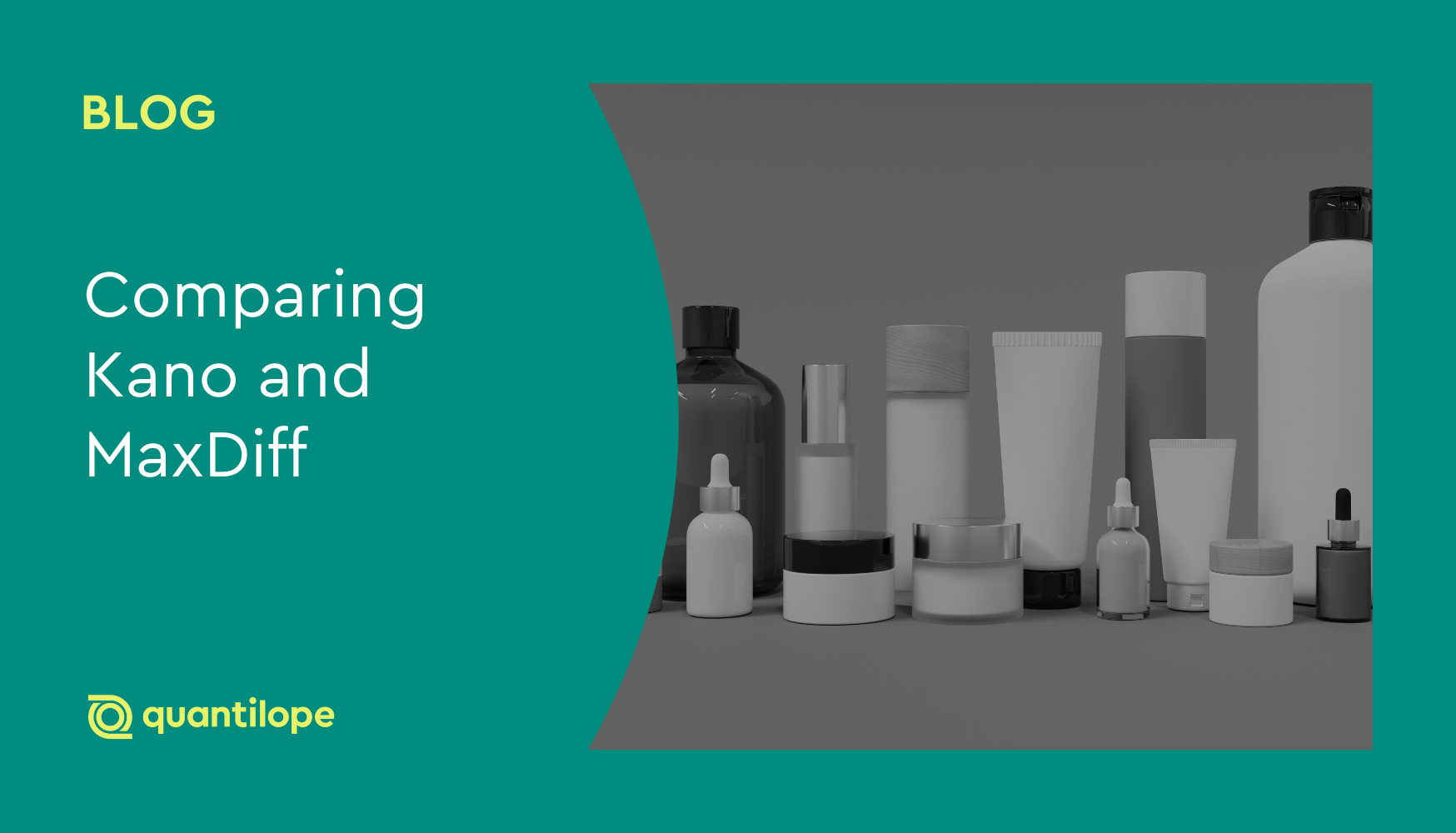Table of Contents:
- A brief summary of each method?
- Kano: Understanding customer satisfaction drivers
- MaxDiff: Prioritizing features and attributes
- Are Kano and MaxDiff Interchangeable research methods?
- Which method should you use to capture detailed quantitative data about your brand?
- How can quantilope help?
A brief summary of each method:
Leveraging advanced methods in consumer market research is a sure way to add value to otherwise standard descriptive questions.
Two advanced methods in particular - Kano and MaxDiff are advanced methods used to prioritize features, closely understand customer preferences and customer satisfaction, and guide new product development. They can help brands determine which features are essential, which might be nice to have, and which are irrelevant to the overall customer experience. While similar in these senses, each of these methodologies serve a distinct purpose and result in different insights.
Selecting the right methodology depends on your research objectives and the aspects of your product or service you’re aiming to evaluate. Below we’ll explore each method in more detail to help guide you in choosing the right one for your needs.
Back to Table of Contents
Kano: Understanding customer satisfaction drivers
The Kano model (named after professor/Dr. Noriaki Kano) is a customer satisfaction framework that categorizes product features. It’s commonly used in conjunction with a Key Driver Analysis (KDA), to investigate the type of relationship between an outcome and the features used in the KDA.
Kano starts with a list of potential features or attributes that researchers want to explore for their product/service. For each of these features/attributes, respondents will see a positive/negative version of a question related to it; for example: "How would you feel if this product had [feature]?” and "How would you feel if this product didn't have [feature]?" These pairings are known as functional/dysfunctional questions (respectively).
With the collected data, a Kano model categorizes the tested features or attributes into five distinct types:
-
Must-be (or must-have): Essential features expected by customers. The absence of these features causes dissatisfaction, but their presence doesn't necessarily increase satisfaction.
-
Performance: Features directly linked to customer satisfaction, where more is always better.
-
Attractive: Features that surprise and delight customers, driving high satisfaction when present but not causing dissatisfaction when absent.
-
Indifferent: Features customers don't care about, and their presence or absence has no impact.
-
Reverse: Features that actually cause dissatisfaction when present.
Kano analysis helps prioritize product development efforts, ensuring resources are focused on features that truly matter to customers. Researchers will analyze the distribution of responses for each feature to determine which of the categories above it falls into, and focus on the ones that have the most impact on customer satisfaction.
Aside from product development, the Kano model is helpful for competitive analysis (evaluating competitor offerings for differentiation) and general consumer market research (exploring needs and expectations for business or marketing strategies).
Benefits of using Kano:
Kano is a great advanced method to leverage when a business is looking to better understand how customer feedback can drive new product development and innovation. It focuses on customer needs, prioritizes based on impact, and allows businesses to continuously monitor and improvement customer satisfaction.
Back to Table of Contents
MaxDiff: Prioritizing Features and Attributes
MaxDiff (Maximum Difference Scaling) is another quantitative research method used to prioritize a long list of features, attributes, elements, etc.. Survey participants are shown various sets of these items (again, features, attributes, elements, or some other set of items a brand is looking to prioritize) and asked to indicate the one they prefer the most and the one they prefer the least - within each set. The MaxDiff methodology then automatically analyzes the choice patterns to determine the relative importance of each item tested, resulting in a preference hierarchy.
Because of its forced-tradeoff nature, MaxDiff analysis helps minimize the ‘everything is important’ fallacy in questionnaire research - in which respondents say everything is important to them, without any context as to which they care about the most.
Below is an example from quantilope’s study on Mattress Tracking:![]()
Benefits of using MaxDiff:
MaxDiff is a powerful research method for businesses seeking to prioritize product features based on customer preferences. It allows companies to directly understand which features are most valued by customers, helping guide product development and increase customer satisfaction. MaxDiff provides a clear roadmap for innovation and ensures that resources are allocated to the most impactful new features/improvements.
Back to Table of Contents
🔗 Related: MaxDiff vs Conjoint Analysis: When to Use Which Method in Market Research
Are KANO and MaxDiff interchangeable research methods?
But simply - no, these methods are not interchangeable.
While both methods focus on customer satisfaction and feature prioritization, they address different research questions.
Key differences
-
Focus: Kano Model focuses on categorizing features based on their impact on customer satisfaction, while MaxDiff focuses on determining the relative importance of items within a set.
-
Methodology/Approach: Kano questions include ‘functional’ and ‘dysfunctional’ phrasing for each feature, while MaxDiff presents respondents with a series of tradeoff decisions/tasks.
-
Output: Kano Model categorizes features into 5 groups while MaxDiff produces a ranked list of items based on their preference scores.
Back to Table of Contents
Which method should you use to capture detailed quantitative data about your brand?
While both highly valuable advanced methods, choosing between Kano and MaxDiff really depends on your research objectives.
-
Kano: Choose Kano if you want to understand how different features influence customer satisfaction and dissatisfaction. This is particularly helpful during product development or product enhancement stages.
-
MaxDiff: Use MaxDiff if you need to prioritize a set of features or attributes to guide new marketing campaigns, develop new product concepts, or evaluate brand preferences.
In some cases, using both methods in a study can provide a comprehensive view of customer preferences. Kano can help you identify which features are most critical to customer satisfaction, while MaxDiff can then help you prioritize those features to determine which ones to focus on first.
Back to Table of Contents
quantilope streamlines advanced research methods like Kano and MaxDiff, with a total of 15 automated methodologies to choose from. Researchers of any skillset can easily create an advanced method study by dragging and dropping their chosen method, customizing as needed, and reviewing the suggested method settings.
quantilope studies display all data in real-time, so researchers can monitor the results of their Kano and MaxDiff as respondents complete the survey. While in field, or anytime after, researchers can choose between a variety of chart visualizations for each method, and slice their metrics by demographic groups, buyer profiles, or other criteria to use in their final insights dashboard (which also updates in real-time with any new data for dashboard charts).
To learn more about Kano, MaxDiff, or any of quantilope’s other advanced methodologies (including Conjoint analysis, Segmentation, A/B testing, and more), get in touch below!



.png)
